Indonesia, known for its stunning landscapes and rich natural heritage, is home to a remarkable array of flora and fauna. With approximately 25,000 flowering plants, 515 species of mammals, 781 species of reptiles, 1,592 species of birds, and 270 species of amphibians, the country boasts an impressive level of biodiversity. From the tropical rainforests to the mesmerizing marine life, Indonesia’s diverse ecosystems provide a vital habitat for countless species.
However, this biodiversity is under threat. Habitat degradation, overexploitation, pollution, and climate change pose significant challenges to the delicate balance of nature in Indonesia. The destruction of habitats, such as deforestation for agriculture and infrastructure development, disrupts the ecosystems and pushes species to the brink of extinction.
Conservation efforts are essential to preserving Indonesia’s unique biodiversity. National parks, nature reserves, and conservation initiatives play a crucial role in protecting endangered species and their habitats. Through sustainable practices and increased public awareness, it is possible to safeguard the future of Indonesia’s extraordinary flora and fauna.
Key Takeaways
- Indonesia is home to a diverse range of plant and animal species, with thousands of flowering plants and hundreds of mammal, reptile, bird, and amphibian species.
- Habitat degradation, overexploitation, pollution, and climate change are threatening Indonesia’s biodiversity.
- Conservation efforts, including the establishment of national parks and nature reserves, are crucial for protecting endangered species and preserving habitats.
- Sustainable practices and increased public awareness are essential for ensuring the long-term survival of Indonesia’s unique flora and fauna.
The Importance of Indonesia’s Biodiversity
Indonesia’s biodiversity plays a crucial role in maintaining essential ecosystem services. One of the most biodiverse habitats on the planet is found in its tropical rainforests, supporting a wide range of flora and fauna. The marine life found in Indonesia’s waters, including its coral reefs and mangroves, also exhibits a high level of diversity.
These ecosystems provide vital services, such as carbon sequestration, water purification, and coastal protection. The tropical rainforests help in the sequestration of carbon dioxide, mitigating climate change. The rich marine life contributes to the overall health of our oceans and sustains vibrant coastal communities.
Indonesia’s biodiversity not only supports the well-being of local communities but also offers invaluable benefits on a global scale. The lush tropical rainforests serve as a natural habitat for numerous plant and animal species, safeguarding their survival and genetic diversity. The continued preservation of this biodiversity is essential for maintaining the delicate balance of our planet’s ecosystems.
“The richness of Indonesia’s biodiversity is awe-inspiring, from the lush canopies of its rainforests to the vibrant coral reefs beneath its azure waters.”
Through its sheer biodiversity, Indonesia contributes to the intricate web of life on Earth. This biodiversity offers us opportunities for scientific research, potentially unlocking new discoveries that can benefit various fields, including medicine, agriculture, and technology. It is our responsibility to protect and preserve these invaluable natural treasures for future generations.
Ecosystem services provided by Indonesia’s biodiversity are not only essential for environmental sustainability but also for the socio-economic well-being of communities. For example, the carbon sequestration capabilities of tropical rainforests can help mitigate climate change, benefiting global efforts to combat environmental threats.
Moreover, preserving and protecting the marine life-rich coastal areas maintain the health of our oceans, ensuring the livelihoods of fishing communities and supporting tourism, which in turn bolsters local economies. The intrinsic value of Indonesia’s biodiversity extends far beyond individual species, having wide-ranging impacts on both natural and human systems.
Enhancing Conservation Efforts
To safeguard Indonesia’s biodiversity, it is crucial to prioritize conservation efforts. This includes establishing and managing protected areas, implementing sustainable resource management practices, and raising awareness about the importance of biodiversity.
Efforts must be made to address the challenges of habitat degradation, overexploitation, pollution, and climate change that threaten Indonesia’s biodiversity. Collaborative initiatives involving government agencies, local communities, NGOs, and international organizations are essential to ensure the long-term conservation of this crucial natural heritage.
| Threats to Indonesia’s Biodiversity |
Conservation Measures |
| Habitat degradation |
Establishment of protected areas |
| Overexploitation |
Implementation of sustainable resource management practices |
| Pollution |
Environmental awareness campaigns and stricter regulations |
| Climate change |
Adaptation and mitigation strategies, promoting sustainable practices |
By investing in biodiversity conservation, Indonesia can secure the well-being of its ecosystems, protect endangered species, and contribute to global efforts to address pressing environmental challenges. A comprehensive and multi-faceted approach is necessary to ensure the sustainable development of the nation while safeguarding its rich biodiversity.
Threats to Indonesia’s Biodiversity
The rich biodiversity of Indonesia is under threat from various factors, including habitat degradation, overexploitation, pollution, and climate change. These challenges pose significant risks to the diverse flora and fauna that call Indonesia home.
Habitat Degradation and Fragmentation
One of the primary threats to Indonesia’s biodiversity is habitat degradation and fragmentation. Land conversion for agriculture and infrastructure development leads to the loss of crucial habitats for many species. As forests are cleared and fragmented, the natural balance of ecosystems is disrupted, affecting the survival of numerous plant and animal species.
Overexploitation of Natural Resources
The overexploitation of natural resources is another major threat to Indonesia’s biodiversity. Activities such as illegal logging, poaching, and destructive fishing practices put immense pressure on vulnerable species. These practices disrupt natural ecosystems and can lead to the decline and potential extinction of various flora and fauna.
Pollution
Pollution from industrial and agricultural activities also poses a significant threat to Indonesia’s biodiversity. Chemical pollutants, waste disposal, and oil spills in aquatic environments can have devastating impacts on marine life and the ecosystems that support them. Pollution can disrupt delicate ecological balances and harm species that are unable to adapt to changing conditions.
Climate Change
Climate change further exacerbates the threats to Indonesia’s biodiversity. Rising temperatures, changing rainfall patterns, and extreme weather events can disrupt ecosystems and have cascading effects on plant and animal populations. Species that are unable to adapt or migrate to more suitable habitats may face increased vulnerability to extinction.
To address these threats and safeguard Indonesia’s biodiversity, it is crucial to implement sustainable conservation practices, strengthen regulations, and promote awareness about the importance of preserving ecosystems. By taking collective action, we can protect the rich biodiversity of Indonesia for future generations to enjoy.
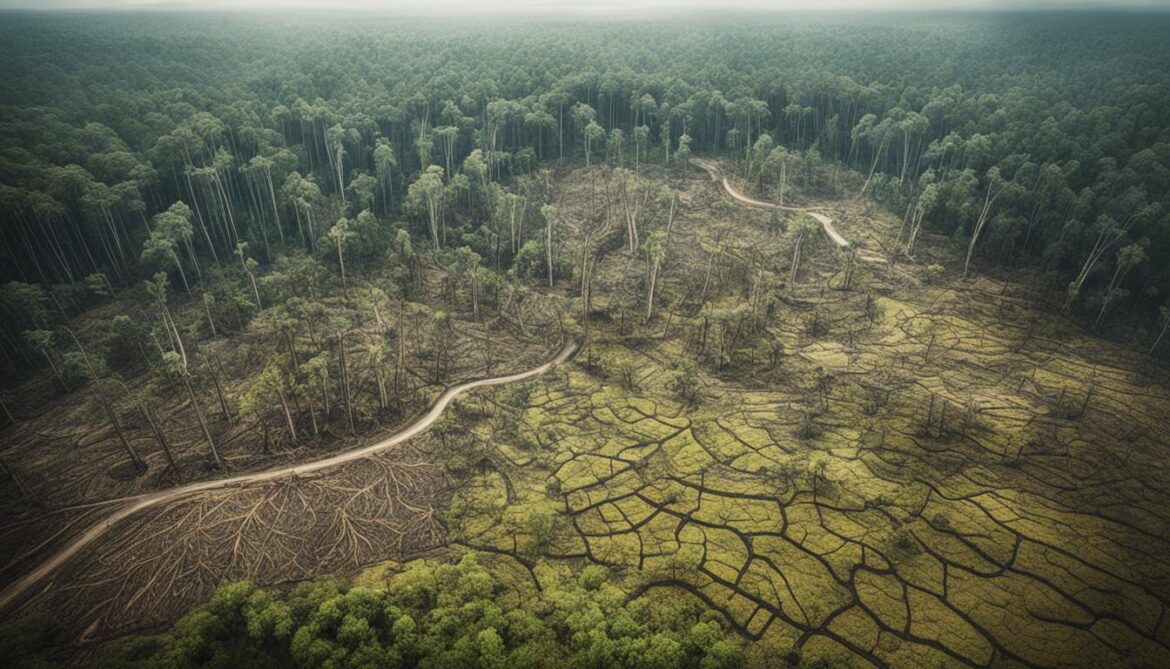
Conservation Efforts in Indonesia
Indonesia is committed to protecting its rich biodiversity through various conservation initiatives. The country has established 566 national parks spanning over 36,069,368.04 million hectares. These national parks encompass a range of protected areas, including nature reserves, game reserves, hunting parks, grand forest parks, and nature tourism parks. The diverse array of protected areas ensures the preservation of Indonesia’s unique flora and fauna.
In addition to national parks, Indonesia has also implemented community-based forestry projects that actively involve local communities in sustainable resource management. This approach fosters a sense of ownership and responsibility among the local population, ensuring the long-term conservation of biodiversity.
The Indonesian government has developed the Indonesian Biodiversity Strategy and Action Plan (IBSAP) to guide its conservation efforts. This comprehensive plan aims to enhance coordination among various stakeholders and implement effective strategies for the protection and preservation of Indonesia’s biodiversity.
Conservation Initiatives in Indonesia
Indonesia’s commitment to conservation is further demonstrated through specific initiatives aimed at protecting its unique biodiversity. These initiatives include:
- The Turtle Conservation and Education Centre: This centre focuses on the conservation of marine turtles, with a primary focus on education and raising awareness about the threats these species face.
- The Sumatran Orangutan Conservation Programme: This program aims to conserve the critically endangered Sumatran orangutan, focusing on habitat restoration, research, and community engagement.
- The BirdLife Indonesia Partnership: This partnership coordinates various bird conservation activities, including habitat protection, species monitoring, and public awareness campaigns.
These conservation initiatives, along with the establishment of national parks and community-driven projects, contribute to the overall preservation of Indonesia’s diverse ecosystems.
Indonesia’s Protected Areas
Indonesia’s protected areas not only safeguard its biodiversity but also offer opportunities for eco-tourism and nature enthusiasts. These areas provide visitors with a chance to witness the country’s incredible wildlife, stunning landscapes, and unique plant species. Some notable protected areas in Indonesia include:
“The Raja Ampat Islands in West Papua are known for their breathtaking coral reefs, making them a popular diving destination. The Komodo National Park, home to the iconic Komodo dragon, offers visitors a chance to explore its pristine beaches and remarkable biodiversity. Additionally, the Ujung Kulon National Park, a UNESCO World Heritage Site, preserves the critically endangered Javan rhinoceros and offers a glimpse into Indonesia’s natural wonders.”
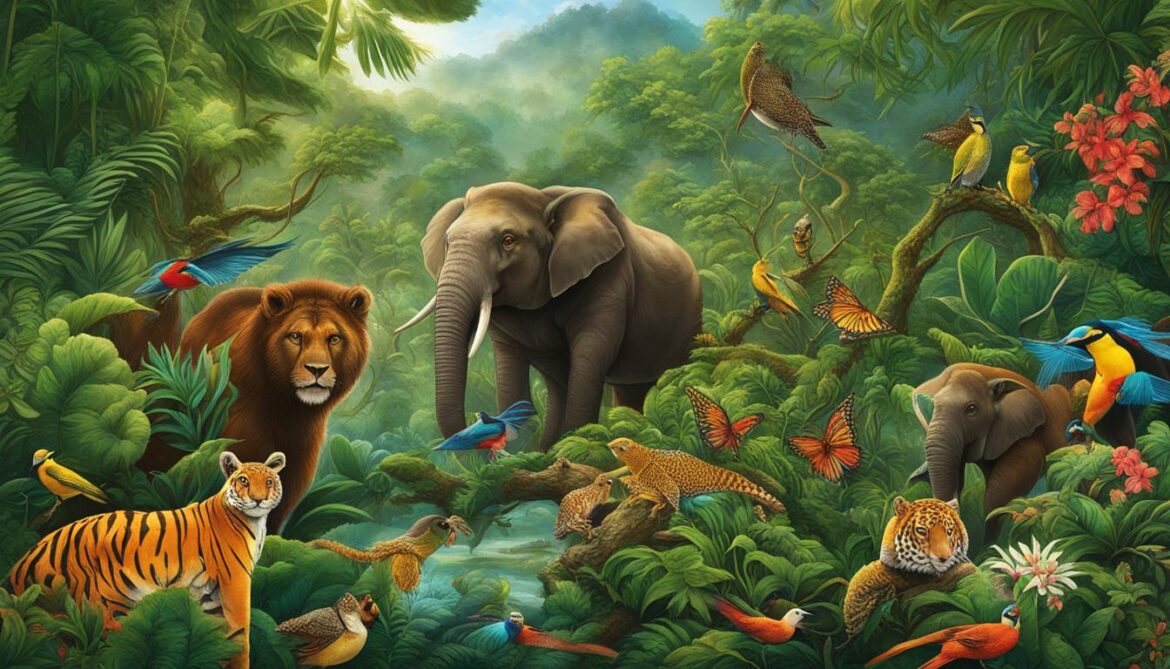
Selected National Parks in Indonesia
| National Park |
Location |
Main Features |
| Gunung Leuser |
North Sumatra and Aceh |
Orangutans, Sumatran tigers, elephants |
| Way Kambas |
Lampung |
Rhinos, elephants, tigers |
| Komodo |
East Nusa Tenggara |
Komodo dragons, marine life |
| Tanjung Puting |
Central Kalimantan |
Orangutans, proboscis monkeys, sun bears |
These national parks serve as crucial sites for nature conservation and provide a vital refuge for endangered species, helping to ensure their survival for future generations.
Challenges in Biodiversity Conservation
Biodiversity conservation in Indonesia faces several challenges. Weak governance, including corruption and overlapping authorities, hinders effective management. Habitat loss and degradation due to land conversion, illegal logging, and destructive fishing practices pose significant threats to biodiversity. Insufficient resources and capacity, both at the national and local levels, limit the enforcement of biodiversity-related laws and policies. Strengthening governance, increasing awareness, and promoting sustainable practices are crucial to address these challenges.
“The weak governance in Indonesia’s biodiversity conservation efforts undermines the effectiveness of management. Corruption and overlapping authorities create barriers to implementing robust policies and strategies.”
One of the major challenges is habitat loss and degradation. Land conversion for agriculture and infrastructure development has resulted in the destruction of natural habitats, leading to the displacement and potential extinction of many species. Illegal logging activities further exacerbate the loss of critical forest ecosystems, disrupting the delicate balance of biodiversity.
Persistent Illegal Activities
Illegal activities, such as poaching and destructive fishing practices, also pose significant risks to Indonesia’s biodiversity. Poaching threatens iconic species like elephants, rhinos, and tigers, while destructive fishing practices harm marine ecosystems and diminish fish populations. These illegal activities not only impact the delicate balance of biodiversity but also hinder conservation efforts.
- Promote sustainable practices to conserve biodiversity:
- Implement sustainable land-use practices that minimize habitat loss.
- Encourage responsible logging practices and support alternative livelihoods for local communities.
- Enforce stricter regulations on fishing practices to mitigate the negative impacts on marine biodiversity.
Strengthen governance and law enforcement:
- Combat corruption and ensure transparency in biodiversity conservation initiatives.
- Enhance coordination between different authorities to eliminate overlapping responsibilities and promote effective management.
- Allocate sufficient resources to enforce biodiversity-related laws and regulations.
Increase public awareness and engagement:
- Educate the public about the importance of biodiversity and its link to human well-being.
- Encourage citizen science initiatives to involve local communities in collecting data and monitoring biodiversity.
- Promote eco-tourism as a sustainable way to appreciate and conserve Indonesia’s unique biodiversity.
The Way Forward
Addressing the challenges in biodiversity conservation requires collaborative efforts from all stakeholders, including the government, local communities, NGOs, and international partners. By strengthening governance, increasing awareness, and promoting sustainable practices, Indonesia can overcome these challenges and protect its invaluable biodiversity for future generations.
| Challenge |
Impact |
Solution |
| Weak Governance |
Hinders effective management |
Combat corruption, ensure transparency, and enhance coordination |
| Habitat Loss |
Displacement and potential extinction of species |
Promote sustainable land-use practices and enforce responsible logging |
| Illegal Activities |
Threat to iconic species and marine biodiversity |
Enforce stricter regulations and support alternative livelihoods |
| Insufficient Resources |
Limit enforcement of biodiversity-related laws |
Allocate sufficient resources and enhance capacity-building |
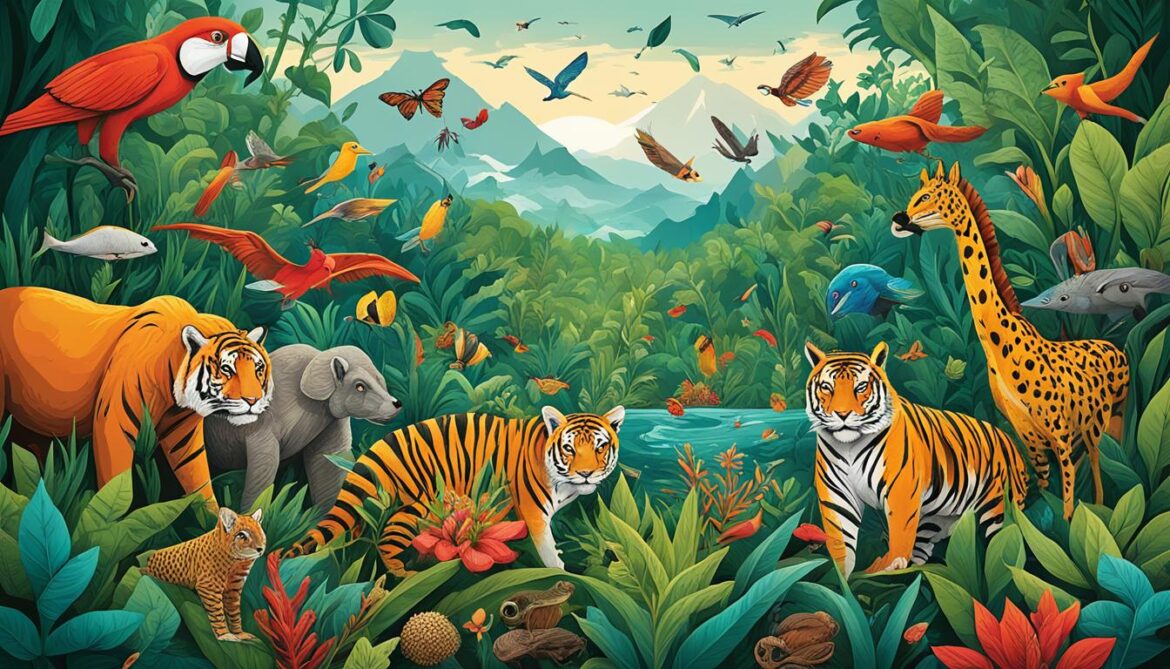
Policies and Governance for Biodiversity Conservation
The Government of Indonesia has implemented key policies and legislation to support the preservation of Indonesia’s biodiversity. These include the Conservation of Biological Resources and Their Ecosystems Law, Preservation of Wildlife and Plant Species Regulation, Environmental Protection and Management Law, Forestry Law, Fisheries Law, and Coastal and Small Islands Management Law. These laws aim to safeguard the diverse flora and fauna of Indonesia, regulate the management of natural resources, and promote environmental sustainability throughout the country.
One of the significant legislation is the Conservation of Biological Resources and Their Ecosystems Law which provides a legal framework for the protection and sustainable management of Indonesia’s biodiversity. The law outlines regulations and guidelines for biodiversity conservation, including the establishment of national parks, nature reserves, and protected areas. It also emphasizes the importance of community participation in conservation efforts and the promotion of sustainable practices.
The Preservation of Wildlife and Plant Species Regulation is specifically aimed at safeguarding endangered species and their habitats. It enforces strict regulations regarding the hunting, trading, and transportation of protected wildlife and plant species, ensuring their continued existence in their natural environments.
“The preservation of Indonesia’s biodiversity is crucial not only for the nation but also for the global community. Our laws and regulations provide a strong foundation for the conservation of our unique flora and fauna, but effective enforcement and governance remain ongoing challenges.” – Minister of Environment and Forestry of Indonesia
The Environmental Protection and Management Law focuses on the sustainable management of natural resources and the prevention of environmental degradation. It aims to reduce pollution, regulate waste management, and promote sustainable land use practices to safeguard the country’s ecosystems and biodiversity.
The Forestry Law and Fisheries Law work hand in hand to protect Indonesia’s rich forest and marine biodiversity. They outline regulations for sustainable forestry practices and responsible fishing techniques, ensuring the conservation of vital ecosystems and the sustainable utilization of natural resources.
Furthermore, the Coastal and Small Islands Management Law aims to address the specific conservation needs of Indonesia’s coastal areas and small islands. It emphasizes the protection of coastal ecosystems, including coral reefs and mangroves, which are vital habitats for a diverse range of marine species.
While these laws and regulations demonstrate the government’s commitment to biodiversity conservation, challenges such as weak enforcement and governance issues still need to be addressed. Strengthening enforcement and enhancing governance mechanisms are crucial to ensure the effective implementation of these policies and the long-term protection of Indonesia’s valuable biodiversity.
The table below showcases key biodiversity laws and regulations in Indonesia:
| Legislation |
Description |
| Conservation of Biological Resources and Their Ecosystems Law |
Provides a legal framework for biodiversity conservation and sustainable management. |
| Preservation of Wildlife and Plant Species Regulation |
Regulates the hunting, trading, and transportation of protected wildlife and plant species. |
| Environmental Protection and Management Law |
Focuses on the sustainable management of natural resources and prevention of environmental degradation. |
| Forestry Law |
Outlines regulations for sustainable forestry practices and protection of forest ecosystems. |
| Fisheries Law |
Regulates responsible fishing practices and ensures the conservation of marine biodiversity. |
| Coastal and Small Islands Management Law |
Addresses the specific conservation needs of coastal areas and small islands. |
These laws play a vital role in preserving Indonesia’s biodiversity and promoting sustainable development. By adhering to these regulations and strengthening governance, Indonesia can continue to protect its natural heritage for future generations, while ensuring the sustainable utilization of its diverse ecosystems.
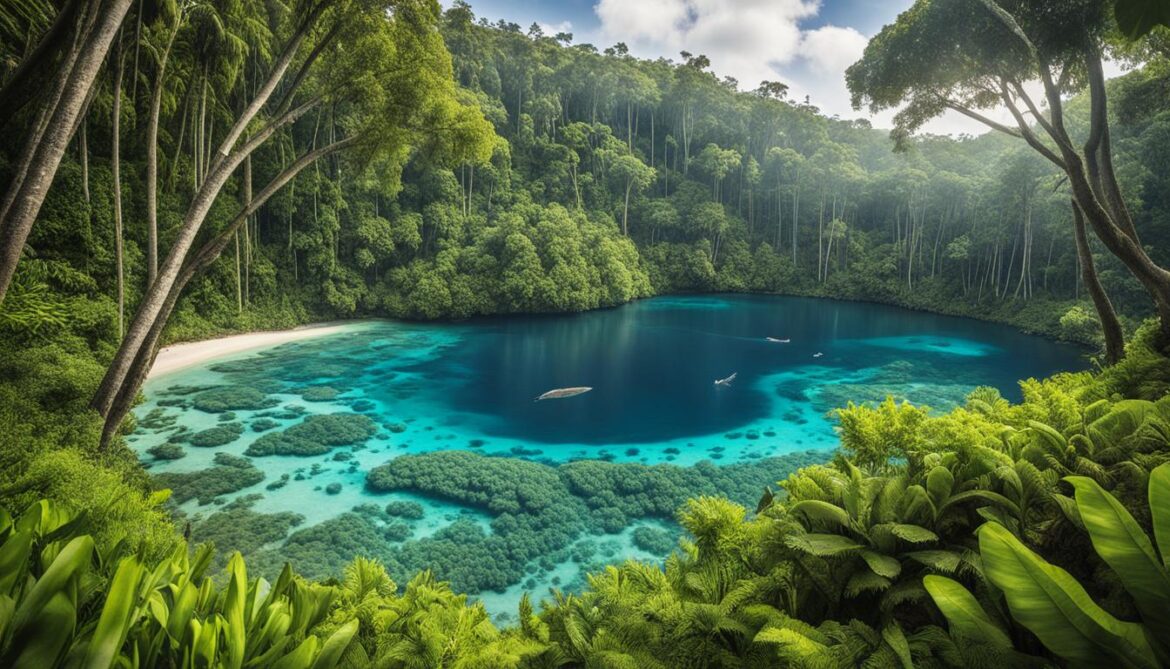
Initiatives and Development Plans for Biodiversity Conservation
Indonesia has implemented several initiatives and development plans to ensure the conservation of its valuable biodiversity. These efforts focus on sustainable financing and marine conservation, promoting the long-term protection of natural resources and the well-being of local communities.
The Tropical Landscapes Finance Facility plays a crucial role in financing sustainable rubber production and conservation projects. By providing the necessary funds, this initiative supports environmentally friendly practices and aids in the preservation of Indonesia’s diverse flora and fauna.
The Coral Reef Rehabilitation and Management Program is dedicated to safeguarding coral reefs from destructive fishing practices and pollution. Recognizing the importance of these fragile ecosystems, this program works towards their restoration and preservation to maintain the rich marine life in Indonesia’s waters.
The Sulu-Sulawesi Seascape project has set its sights on improving fisheries management and establishing marine protected areas. By implementing sustainable fishing practices and protecting critical habitats, this project aims to conserve the marine biodiversity found within Indonesia’s seascape.
These initiatives exemplify the country’s commitment to sustainable development while simultaneously protecting its diverse ecosystems. Through collaboration between government agencies, organizations, and local communities, Indonesia endeavors to maintain its remarkable biodiversity for future generations to enjoy.
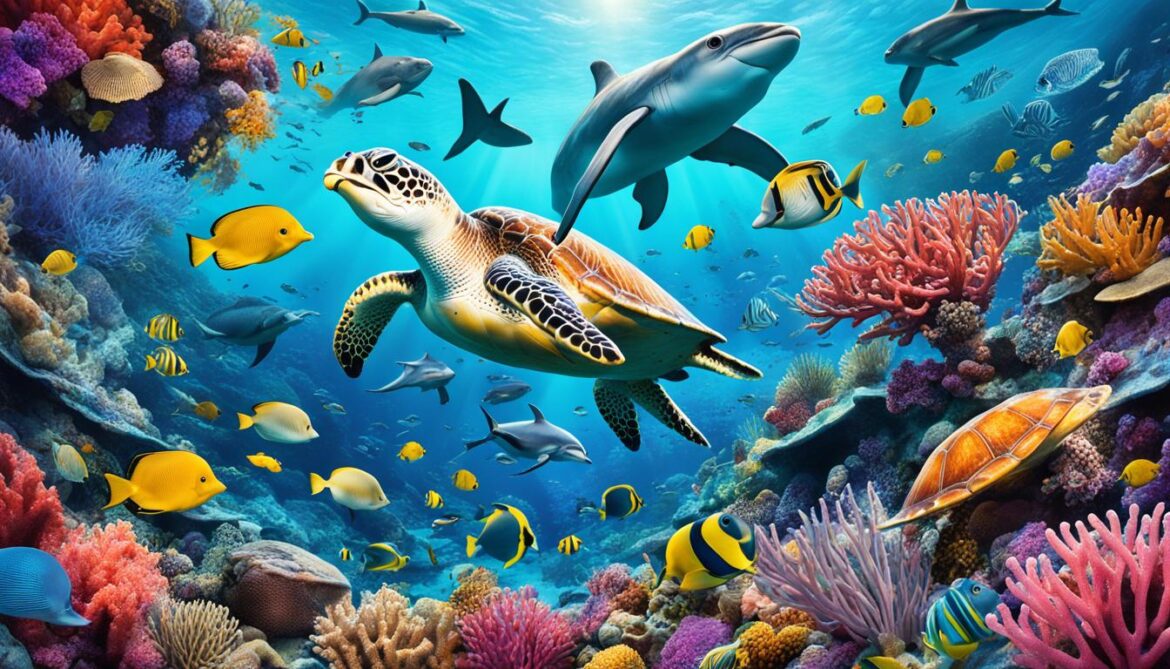
Furthermore, these conservation efforts not only preserve Indonesia’s biodiversity but also provide numerous benefits to local communities. By enabling sustainable practices, these initiatives ensure the continued availability of essential resources and support livelihoods that rely on the conservation of marine ecosystems.
Promoting Sustainable Financing and Conservation
The Tropical Landscapes Finance Facility, established in partnership with various stakeholders, acts as a catalyst for sustainable financing. By providing funding for sustainable rubber production, this initiative promotes environmentally friendly practices and supports conservation efforts.
The Sustainable Rubber Platform, a key component of this facility, fosters transparency and accountability in the rubber value chain. It works towards sustainable and responsible rubber production, protecting the natural habitats that are home to countless species and enhancing the resilience of local communities.
The Coral Reef Rehabilitation and Management Program takes a holistic approach to preserve coral reefs. It focuses on building the capacity of local communities to participate in reef restoration, implementing sustainable fishing practices, and mitigating pollution from various sources.
The Sulu-Sulawesi Seascape project recognizes the importance of marine ecosystems and aims to strengthen the management of fisheries in the region. By establishing marine protected areas and promoting sustainable fishing practices, this project seeks to secure the livelihoods of local communities while conserving marine biodiversity.
| Initiative |
Funding |
Focus Area |
| Tropical Landscapes Finance Facility |
Financing for sustainable rubber production |
Conservation and sustainable practices |
| Coral Reef Rehabilitation and Management Program |
Raising funds for coral reef restoration |
Preserving coral reefs and marine ecosystems |
| Sulu-Sulawesi Seascape project |
Improved fisheries management |
Establishing marine protected areas |
Through these conservation initiatives and development plans, Indonesia strives to strike a balance between protecting its natural heritage and fostering sustainable development. By prioritizing biodiversity conservation, the country ensures the preservation of its unique ecosystems and the well-being of its people for generations to come.
Indonesia’s Unique Biodiversity Hotspots
The Leuser ecosystem in Sumatra is undoubtedly one of Indonesia’s most remarkable biodiversity hotspots. This extraordinary region supports a diverse range of species, including magnificent elephants, majestic rhinos, awe-inspiring tigers, and delightful orangutans.
However, this precious ecosystem is under threat. Habitat loss resulting from human activities, such as deforestation and infrastructure development, poses a significant challenge. Moreover, human-wildlife conflict and poaching further endanger the delicate balance of this remarkable ecosystem.
“Conservation is the key to preserving the beautiful Leuser ecosystem,” says Dr. Maya Malik, a renowned wildlife biologist. “By protecting this unique habitat and its diverse species, we can ensure the survival of not only this extraordinary place but also the incredible animals that call it home.”
Recognizing the urgency of the situation, a partnership called the Lion’s Share Fund has been established to protect the Leuser ecosystem. This collaboration focuses on a three-pronged approach of ecosystem restoration, sustainable financing, and conservation-based development. By combining these efforts, the partnership aims to safeguard the biodiversity and ecological integrity of the Leuser ecosystem.
The United Nations Environment Programme (UNEP) is also actively involved in raising awareness about the importance of the Leuser ecosystem and promoting conservation efforts. Through education and advocacy, UNEP strives to highlight the ecological significance of this unique hotspot and inspire individuals and communities to contribute to its preservation.
As Dr. Malik aptly puts it, “Our collective actions today will determine the fate of the Leuser ecosystem and its diverse inhabitants. Let us come together to protect this natural wonder and forge a sustainable future for all.”

| Species |
Status |
| Sumatran Elephant |
Endangered |
| Sumatran Rhino |
Critically Endangered |
| Sumatran Tiger |
Critically Endangered |
| Sumatran Orangutan |
Critically Endangered |
Raising Awareness for Indonesia’s Biodiversity
UNEP’s Wild for Life campaign is dedicated to increasing public awareness about Indonesia’s rich biodiversity and the urgent need for conservation. Through this initiative, people can learn more about endangered species and their crucial role in maintaining the delicate balance of ecosystems. By engaging the public through captivating quizzes and educational content, the campaign aims to foster a deeper understanding of the importance of biodiversity and inspire action towards its protection.
By highlighting the unique and diverse range of species found in Indonesia, the Wild for Life campaign seeks to mobilize public support and advocate for stronger policies and enforcement measures. It recognizes that the preservation of endangered species is not only a matter of environmental concern but also crucial for the long-term sustainability of Indonesia’s natural heritage.
“The future of Indonesia’s biodiversity depends on the collective efforts of individuals, communities, and policymakers. Through the Wild for Life campaign, we can work together to ensure the preservation of these invaluable species and their habitats.” – UNEP spokesperson
With increased public support, the Wild for Life campaign aims to raise awareness at local and global levels, emphasizing that every individual can make a difference in safeguarding Indonesia’s biodiversity. By encouraging sustainable practices, advocating for conservation-friendly policies, and promoting responsible consumption, the campaign aims to empower individuals to be active participants in the protection of endangered species.
Join the Wild for Life campaign and help save Indonesia’s endangered species:
- Stay informed about Indonesia’s biodiversity and the conservation challenges it faces.
- Engage with educational content and quizzes on the Wild for Life campaign website to test your knowledge and learn more about endangered species in Indonesia.
- Share information and campaign materials on social media to raise awareness among your friends and followers.
- Support local and international organizations working towards biodiversity conservation in Indonesia.
- Advocate for stronger policies and enforcement measures to protect wildlife and their habitats.
By actively participating in the Wild for Life campaign, individuals can contribute to the long-term preservation of Indonesia’s invaluable biodiversity. Together, we can make a difference and ensure a sustainable future for generations to come.
| Endangered Species in Indonesia |
Threats |
Status |
| Sumatran Orangutan |
Habitat loss, poaching, illegal pet trade |
Critically Endangered |
| Javan Rhinoceros |
Habitat loss, poaching |
Critically Endangered |
| Komodo Dragon |
Habitat loss, illegal hunting, human-wildlife conflict |
Vulnerable |
| Bali Starling |
Habitat loss, illegal pet trade |
Critically Endangered |
| Sumatran Tiger |
Habitat loss, poaching |
Critically Endangered |
Conclusion
Indonesia’s biodiversity is a valuable ecological treasure that supports both local communities and the overall health of the planet. Through national parks, conservation initiatives, and sustainable financing mechanisms, efforts have been made to protect and preserve this diverse natural heritage.
However, challenges such as weak governance, habitat loss, and illegal activities continue to pose threats to Indonesia’s biodiversity. To overcome these challenges, it is crucial to strengthen governance, promote sustainable practices, and raise public awareness.
By implementing effective policies, enhancing law enforcement, and engaging local communities, Indonesia can ensure the conservation of its unique biodiversity for future generations. This commitment towards sustainable development will not only benefit the country but also contribute to the global effort of preserving our planet’s natural resources.
FAQ
What is biodiversity?
Biodiversity refers to the variety of plant and animal species in a particular habitat or ecosystem. It encompasses a wide range of flora and fauna, including plants, mammals, reptiles, birds, and amphibians.
Why is Indonesia considered a biodiversity hotspot?
Indonesia is considered a biodiversity hotspot due to its rich and diverse range of species. It is home to approximately 25,000 flowering plants, 515 species of mammals, 781 species of reptiles, 1,592 species of birds, and 270 species of amphibians.
What are the main threats to Indonesia’s biodiversity?
The main threats to Indonesia’s biodiversity include habitat degradation and fragmentation, overexploitation of natural resources, pollution, climate change, and the introduction of alien species.
What conservation efforts are in place to protect Indonesia’s biodiversity?
Indonesia has established 566 national parks covering a total area of 36,069,368.04 million hectares. These parks include nature reserves, game reserves, hunting parks, grand forest parks, and nature tourism parks. Community-based forestry projects have also been implemented, engaging local communities in sustainable resource management.
What are the challenges in biodiversity conservation in Indonesia?
Biodiversity conservation in Indonesia faces challenges such as weak governance, habitat loss and degradation, illegal activities, and insufficient resources and capacity. Strengthening governance, raising awareness, and promoting sustainable practices are essential to address these challenges.
What policies and legislation support biodiversity conservation in Indonesia?
The Government of Indonesia has developed key policies and legislation, including the Conservation of Biological Resources and Their Ecosystems Law, Preservation of Wildlife and Plant Species Regulation, Environmental Protection and Management Law, Forestry Law, Fisheries Law, and Coastal and Small Islands Management Law.
What initiatives and development plans are in place for biodiversity conservation in Indonesia?
Several initiatives and development plans are in place for biodiversity conservation in Indonesia. These include the Tropical Landscapes Finance Facility, which provides financing for sustainable rubber production and conservation efforts, the Coral Reef Rehabilitation and Management Program, and the Sulu-Sulawesi Seascape project.
What are Indonesia’s unique biodiversity hotspots?
One of Indonesia’s unique biodiversity hotspots is the Leuser ecosystem in Sumatra. It supports a diverse range of species, including elephants, rhinos, tigers, and orangutans.
How can we raise awareness for Indonesia’s biodiversity?
The Wild for Life campaign by the United Nations Environment Programme aims to raise awareness about Indonesia’s biodiversity and endangered species. Through quizzes and educational content, the campaign seeks to engage the public and promote stronger policies and enforcement for biodiversity conservation.
Why is biodiversity conservation important for Indonesia?
Biodiversity conservation is crucial for Indonesia as it supports the overall health of the planet and the well-being of local communities. Indonesia’s biodiversity provides important ecosystem services such as carbon sequestration, water purification, and coastal protection.
Source Links






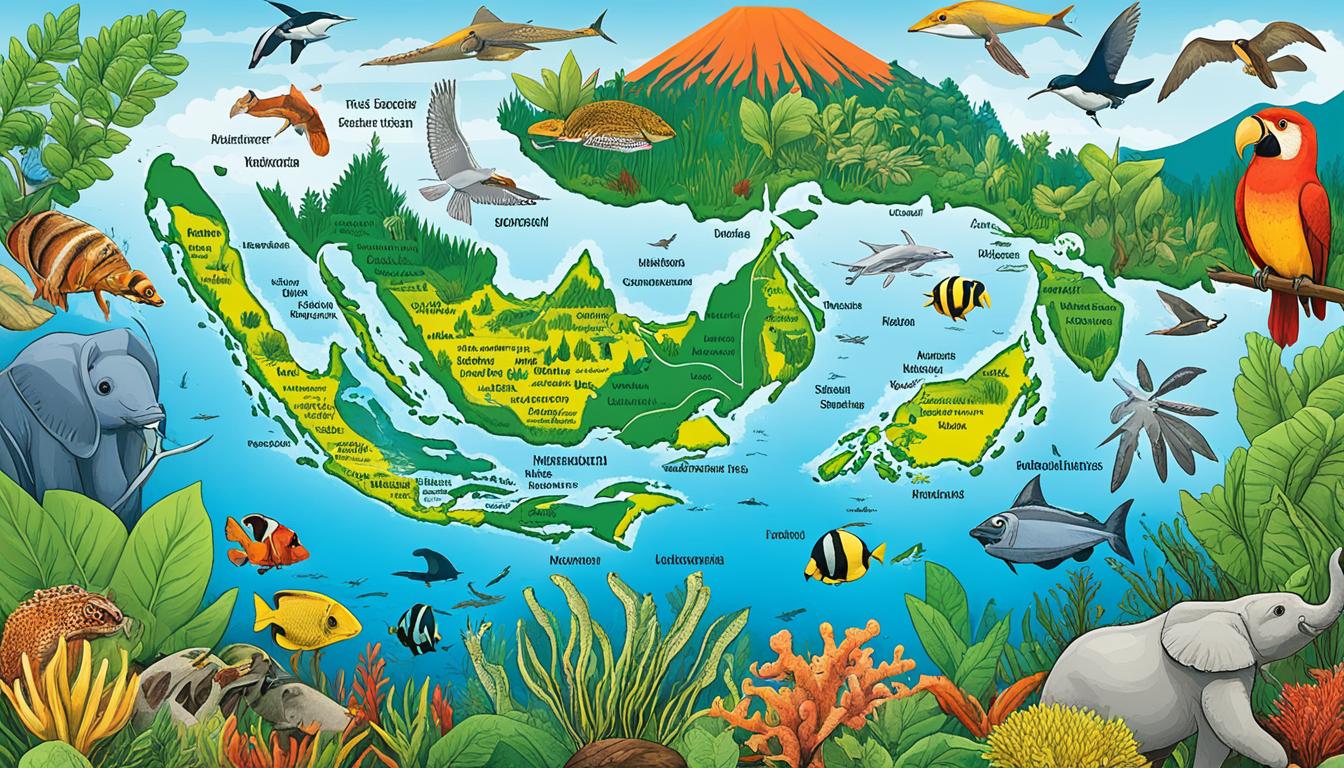

















Post comments (0)